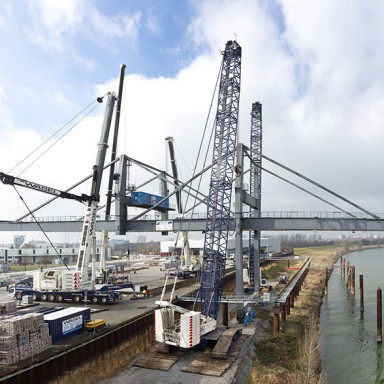
10 minutes - magazine 02 | 2024
On the road
Our new narrow-track crawler crane tackles its first job in Portugal.
LR 1700-1.0W
In a mountainous region of eastern Portugal, an LR 1700-1.0W crawler crane erected a wind turbine in spring. Our newcomer passed its baptism of fire without any problems: The 5.5 megawatt turbine from the manufacturer Enercon is up and running and its imposing rotor star with a diameter of 160 metres is now turning in the Portuguese wind. The unique feature of our brand-new 700-tonne crane is that it can drive to the next location on its crawler carriers – its narrow-track travel gear can navigate paths just over six metres wide. We visited our first delivered specimen on location in the Iberian Peninsula.
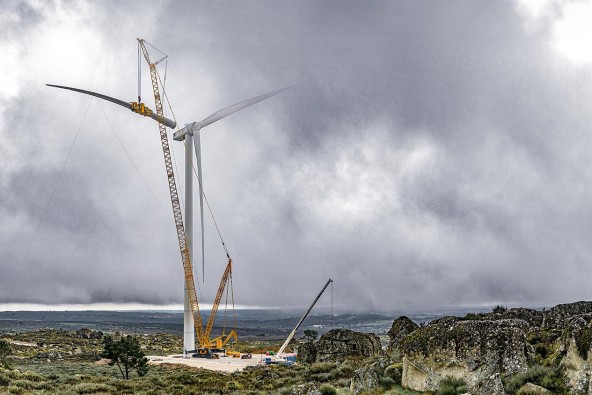
The assembly and dismantling of large crawler cranes is often a much longer job than the actual lifting work. This also applies to jobs in the wind energy sector. When erecting several turbines or building large wind farms, the ability of a crawler crane to drive to the next construction site saves an enormous amount of set-up time. This is because numerous heavy transports, including the necessary load handling, are no longer needed. We have 20 years of experience with cranes on narrow crawler tracks. The LR 1400/2-W was our first machine of this type. But we didnʼt just give the new model – the successor to the LR 1600/2-W – an upgrade. Instead, we completely redesigned the crane and equipped it with a stronger base machine and more powerful travel gear. With its significantly higher load capacities, longer boom system and large-area star-shaped supports, the new machine is ideally positioned – in both senses of the word – to master the challenges of building todayʼs wind turbines with hub heights of up to 170 metres.
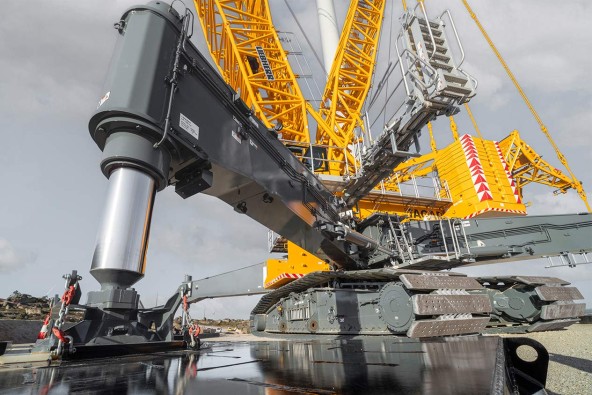
Stable: The star support of the LR 1700-1.0W provides the crane with a solid base measuring around 13.5 by 13.5 metres. “Alignment using the support cylinders is very easy to handle. Levelling by remote control works smoothly and quickly,” says Carlos, one of the crawler craneʼs two drivers.
But back to Portugal. We would like to take you with us, dear readers, as we drive 20 kilometres past the Spanish- Portuguese border through the small town of Sabugal. The route continues westwards uphill, past mighty stone ridges through barren rocky landscapes. Even from a distance, the craneʼs giant lattice boom draws a yellow line on the clear sky. Next to it, the still bladeless wind turbine, which the LR 1700-1.0W has built over the past few weeks, is waiting to be completed. The men and women on the construction site are also waiting – for the arrival of the huge rotor blades. “Unfortunately, the blades arenʼt here yet,” explain Carlos and Samuel, the two drivers of the new crawler crane, after greeting us. Transport problems!
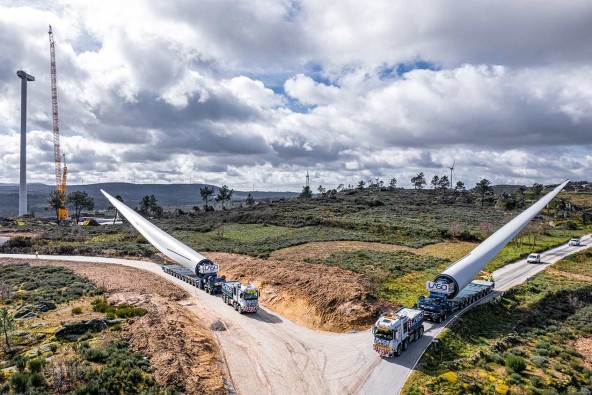
Massive load carriers: The specialised vehicles with up to twelve axles can elevate the 80-metrelong rotor blades on their backs when cornering. The last few metres to the construction site are covered in reverse gear.
The art of waiting
Waiting is part of everyday life on wind turbine construction sites. Itʼs usually the weather that throws the schedule out of kilter. To be more precise: high winds can make crane operations unsafe. Wind speeds of more than ten metres per second are usually the limit. Above this itʼs simply too dangerous. The wind-sensitive rotor blades in particular cannot be held steady enough for their installation. Sometimes, however, the delivery of large or heavy plant components is delayed. Just like now.
However, a few days later they suddenly appear in the distance. In a three-vehicle convoy, the 80-metre-long blades are being transported on man-high, driven multi-axle trailers, pulled by heavy trucks along the small mountain roads. The trio meanders leisurely through the hilly landscape to the construction site.
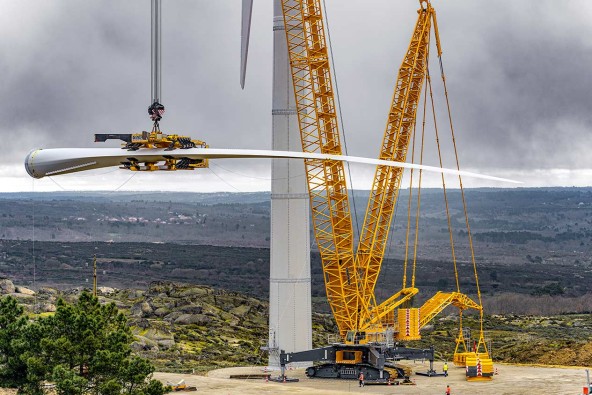
Actually, work could start now, but strong gusts of wind and dense fog repeatedly give Carlos and Samuel, as well as the assembly team, a few more days of tedious waiting. When the wind finally dies down, things progress rapidly. Within 36 hours, all three rotor blades are hoisted by the crawler crane and lifted into place. The Enercon crew is experienced and makes rapid progress, even as low-hanging clouds swirl around the nacelle. And our two crane drivers keep up this pace. Using their new, still somewhat unfamiliar crane, they deliver the bulky components precisely at a height of 120 metres.
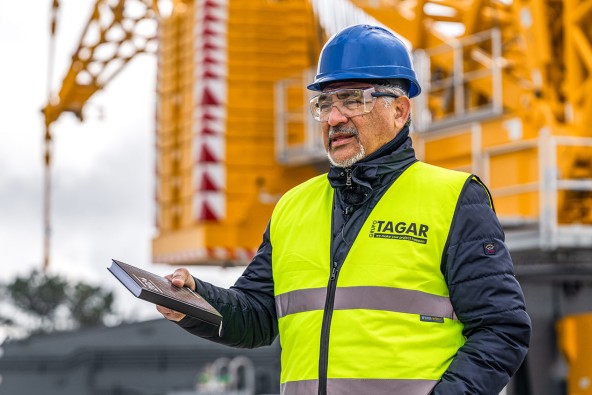
Visit from the boss: Edgar Garcia, the managing partner of GrupoTagar, personally oversees the first deployment of his new narrow-track crawler crane.
“Taller towers every day”
With this in mind, the two men have equipped their crane with a 132-metre lattice boom. At its end is a lattice type fixed jib that adds another twelve metres. “Weʼre actually building taller towers every day. The dimensions of the rotor blades and the weights of the nacelles are constantly increasing. Of course, we also have to keep pace in terms of our cranes, which is why we purchased this machine,” says Edgar Garcia, managing partner of the Tagar Group, which also includes EuroTagar, the company operating the new crane. Garcia has come to the construction site in person to take a look at his new machine. And to exchange ideas with the crane drivers and project managers on site.
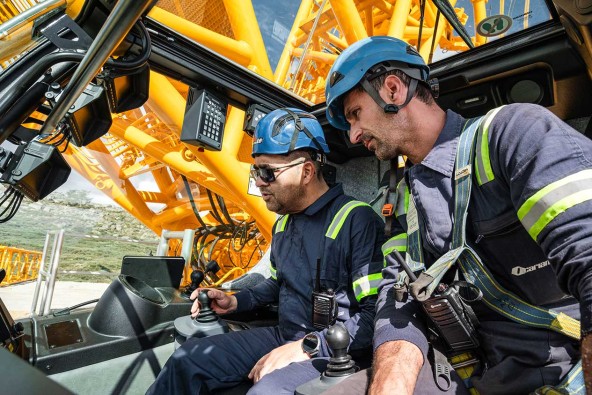
Carlos Lé and Samuel Figueiredo (right): The cab of the LR 1700-1.0W offers space for both crane drivers. Large windows and numerous monitors ensure a complete overview and allow optimum control of the machine.
“GrupoTagar” operates around 100 mobile and crawler cranes and has a broad nationwide presence. With its headquarters in the Porto area and branches in Leiria and the capital Lisbon, the company is represented in all regions of Portugal. A focal point of its activities is the construction of wind turbines. With a strong presence in Chile, Mozambique and Nicaragua, EuroTagar is almost a global player in this industry. “We will mainly use this crane in the wind energy sector. Thatʼs why we opted for the variant with the narrow track system,” says Edgar Garcia. “And because we only have to partially dismantle the lattice boom in order to drive the crane from one construction site to the next on a wind farm, we can save a significant amount of time and effort compared to complete disassembly.” “Weʼre ready to move again about five days earlier,” estimates crane driver Carlos, “than if we had to completely dismantle, transport and reassemble the entire crawler crane.”
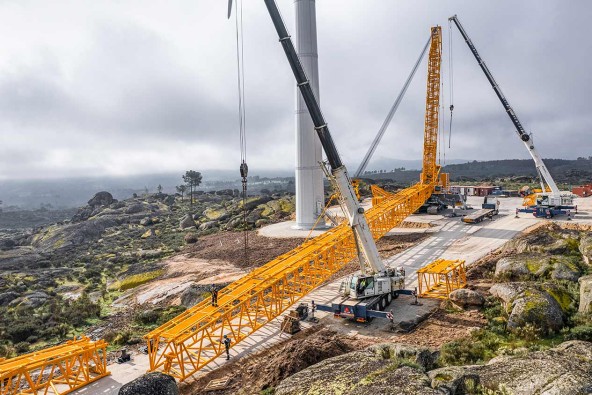
Disassembly: The elements of the lattice boom are removed piece by piece. Some of them are up to 3.50 metres wide. In the end, 70 metres of the boom remain on the base unit. This allows the crane to drive to the next construction site.
Fast handling of loads and ballast
Carlos and Samuel are satisfied. “The crane is really easy and quick to operate. The divisible derrick ballast and its hydraulically adjustable radius save us a lot of time here,” they report. When picking up a rotor blade together with the 25-tonne blade gripper, they need a little extra counterweight due to the distance to the storage area. The small counterweight frame is sufficient for this. It is then simply detached again for lifts with a shorter radius. Even with the heaviest load – the 120-tonne generator – the 70 tonnes of ballast on the small counterweight frame were sufficient. The wide, star-shaped supports and 190 tonnes on the slewing platform give the LR1700-1.0W a secure footing. The two men only need the entire suspended ballast when erecting or taking down the long lattice boom.
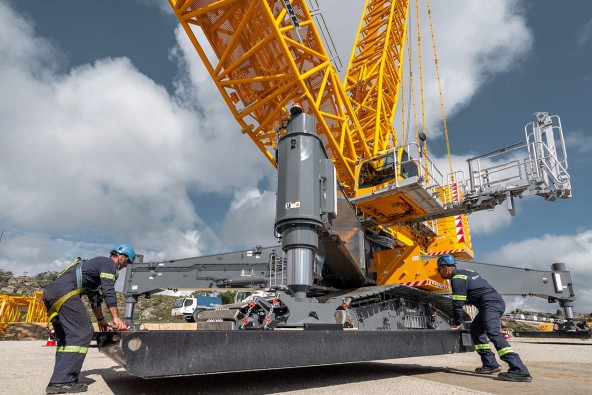
Travel preparations: The load distribution plates at the feet of the mighty support cylinders are aligned for driving. For safety reasons, they are spread as wide as possible – depending on the width of the path – and remain approximately twenty centimetres above the ground while driving. The narrow-track crawler travel gear can handle construction site paths of six to seven metres in width, and can even cope with gradients of up to six degrees.
With the last rotor blade mounted and the turbine finally complete, Carlos and Samuel attach the 200 tonnes of counterweight on the derrick boom. Their crawler crane now needs to be dismantled. Just a few hours later, the huge boom is finally lying on the dusty track. Over the next two days, the men gradually shorten the mast and erect the remaining 70 metres. They are all set for the journey to the next construction site.
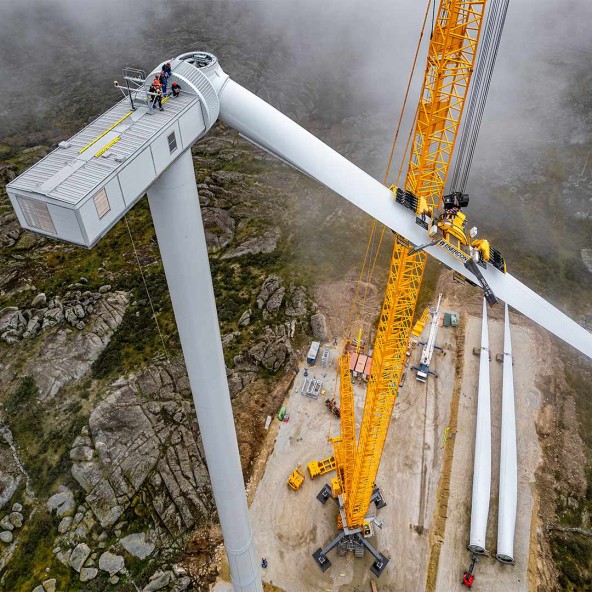
Skyscraper: The first rotor blade is mounted on the hub at a height of 120 metres. From the roof of the nacelle, the fitters can turn and tilt the load via remote control using the ingenious blade gripper. The separate pallets of the derrick ballast can be clearly seen on the ground behind the crane.
Ready to help – even in the middle of the night
Edgar Garcia is also ready to set off. Before the Managing Director takes his leave, he gives us a brief insight into the companyʼs history: “EuroTagar – which includes the companies Cariano SA and Idelgrua Ibérica – has been in the market for over 20 years. Our first unit was a small Liebherr mobile crane with a lifting capacity of 70 tonnes. It was great to work with and the service from Liebherr was so good that we have never bought machines from other manufacturers. Thatʼs still the case today.”
Edgar Garcia has a little anecdote to share on the subject of service: “I remember an incident in Venezuela when one of our cranes had problems at night and blocked the motorway. In Europe it was about five oʼclock in the morning, but we actually got a Liebherr technician on the phone who looked after us for two hours. In such moments of despair, it is just very reassuring to know that you have so much support.”
This article was published in the UpLoad magazine 02 | 2024.


